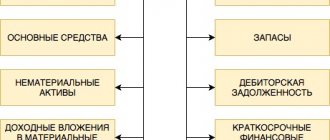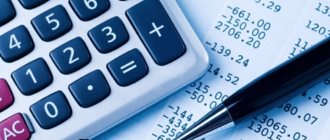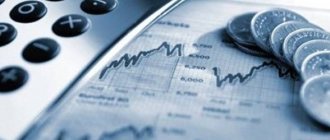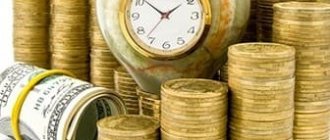What is a balance sheet
Buh.
A balance sheet is a report that shows the financial performance of a company, namely the balances of its accounts as of any date. Most often, organizations prepare the following types of balance sheets:
- introductory (at the time of commencement of activity);
- current (as of a certain date, usually at the end of the year);
- liquidation (at the time of liquidation of the company);
- dividing (during reorganization in the form of division or separation);
- unification (in case of reorganization in the form of affiliation or merger; this balance sheet is introductory at the time the newly created legal entity begins its activities).
The balance sheet clearly shows the financial condition of the company. If you compare it with a similar report compiled, for example, a year ago, you can track the dynamics of the organization’s development.
Check the financial condition of your organization and its counterparties
Balance Sheet Structure
In most cases, the balance sheet of an enterprise is a table divided into two parts: assets and liabilities.
A balance sheet asset is information about the property and liabilities that the company uses in its business activities. They may bring benefits in the future. Assets consist of two sections:
- Fixed assets. This includes property that is used for a long time. In particular, fixed assets, intangible assets, etc.
- Current assets: inventories, accounts receivable, VAT and more.
Balance sheet liabilities are the sources of funds that make up the asset. The passive has three sections:
- Capital and reserves. These include the legal entity’s own funds: authorized capital, additional capital and others.
- Long term duties. They show the company's accounts payable that have existed for a long time: bank loans received for a year or more; deferred tax liabilities and so on.
- Short-term liabilities. With their help, you can understand the size and structure of accounts payable, which is unstable and actively changing. Among other things, these are deferred income and bank loans received for up to a year.
IMPORTANT. The total amount of an asset is always equal to the total amount of a liability. The reason is that each transaction is reflected in accounting using the double entry method using two accounts: the first as a debit, the second as a credit. Lack of equality between asset and liability indicates an error.
The second section of the Balance Sheet asset “Current assets”
The article “Inventories” reflects the total value of assets that are determined by inventories in accordance with PAS 9 “Inventories”, namely industrial inventories, work in progress, finished goods, goods.
So, in the additional article “Production Inventories” you show the cost of stocks of low-value and wear-out items, raw materials, basic and auxiliary materials, fuel, purchased semi-finished products and components, spare parts, containers, building materials and other materials intended for consumption in the course of normal operations. cycle.
The additional item “Work in Progress” shows the costs of work in progress and unfinished work (services), as well as the cost of semi-finished products of own production and the gross debt of customers under construction contracts.
The additional article “Finished Products” shows stocks of products in the warehouse, the processing of which has been completed, which have been tested, accepted, completed in accordance with the terms of contracts with customers and comply with technical specifications and standards. Products that do not meet the above requirements (except for defects), and work that is not accepted by the customer are shown as part of work in progress.
The additional article “Goods” shows, without the amount of trade margins, the cost of goods purchased by enterprises for subsequent sale.
The article “Current biological assets” reflects the value of current biological assets of livestock farming (adult animals for fattening and fattening, poultry, animals, rabbits, adult animals culled from the main herd for sale, young animals for growing and fattening) in a fair or initial cost, as well as crop production (cereals, industrial crops, vegetables and other crops) assessed at fair value, which are accounted for in accordance with Accounting Regulation (Standard) 30 “Biological Assets”.
The additional article “Bills received” shows the debt of buyers, customers and other debtors for shipped products (goods), other assets, work performed and services provided, which is secured by bills.
The article “Receivables for goods of work, Receivables for settlements with the budget” shows receivables from financial and tax authorities, as well as overpayments of taxes, fees and other payments to the budget.
The article “Accounts receivable for advances issued” shows the amount of advances provided to other enterprises for the following payments.
The article “Accounts receivable for accrued income” shows the amount of accrued dividends, interest, royalties, etc., subject to receipt.
The article “Receivables for internal settlements” shows the debt of related parties and receivables for internal settlements.
The article “Other current accounts receivable” shows the debt of debtors, which cannot be included in other items of accounts receivable and which is reflected in current assets.
The article “Current financial investments” reflects financial investments for a period not exceeding one year, which can be freely implemented at any time (except for investments that are cash equivalents).
The article “Cash and cash equivalents” reflects funds on hand, in current and other bank accounts that can be used for current operations, as well as cash equivalents. Funds in national and foreign currencies may be separately included in additional articles to this article.
The article “Deferred expenses” reflects expenses that occurred during the current or previous reporting periods, but relate to the following reporting periods.
The article “Other current assets” reflects the amounts of current assets that cannot be included in the above articles of the section “Current assets”. This article provides, in particular, the balance of subaccounts 331 “Monetary documents in national currency”, 332 “Monetary documents in foreign currency” and 643 “Tax liabilities”.
The third section of the Balance Sheet asset is “Non-current assets held for sale and disposal groups” . The value of the totality of assets that are planned for sale or disposal, and liabilities directly related to such assets that will be transferred (settled) as a result of such a transaction within a year from the date of recognition as intended for sale are reflected.
Balance Passive
Balance sheet form (form)
Previously, the balance sheet bore the official name “Form No. 1”. But in 2011, the Ministry of Finance made changes, and now it is called simply “Balance Sheet”. However, the former name is still used among specialists.
The current form of the balance sheet was approved by order of the Ministry of Finance of Russia dated July 2, 2010 No. 66n. There is an option that is generally used by all companies (given in Appendix No. 1 to this order). Each line is marked with a special code. For example, intangible assets - 1110, inventories - 1210, short-term borrowed liabilities - 1510, etc.
Fill out and print your balance sheet using the current form for free
For organizations that have the right to use simplified accounting methods and submit simplified reporting, a separate balance sheet form has been developed. It is given in Appendix No. 5 to Order No. 66n.
Balance sheet asset analysis
The balance sheet asset consists of two sections:
Fixed assets or non-current assets, which include durable means of production, the cost of which is transferred to the cost of production products gradually over a long time: structures and buildings, roads, technological equipment, copyrights, and so on. Fixed assets and intangible assets are accounted for at their residual value.
Current assets (working capital): means of production that are consumed within one year.
Balance sheet assets also include some items that can only indirectly be considered property. For example, such as deferred expenses or value added tax on acquired assets.
Another meaning of the term “balance sheet asset” is the excess of income over expenses on a company’s balance sheet.
Let's take a closer look at what a balance sheet asset means. A balance sheet asset is part of the enterprise's balance sheet, which reflects in monetary terms the intangible and tangible assets that belong to the enterprise, their location and composition.
How to fill out a balance sheet using Form 1
In each balance line you must indicate the balance of the corresponding account, or the sum of the balances of several accounts. For example, in the line “Value added tax on purchased assets” the balance of account 19 with the same name is entered. In the line “Cash and cash equivalents” - the amount of balances in accounts 50 “Cash”, 51 “Cash accounts”, 52 “Currency accounts” and some others.
There are several basic rules that must be followed when filling out your balance:
- show debit and credit account balances in detail (do not “collapse”);
- fixed assets and intangible assets should be reflected at their residual value (that is, at their original cost minus depreciation);
- Show goods for resale at the purchase price (without trade markup), even if they are accounted for at the sales price;
- data on property and liabilities in the annual balance sheet must be confirmed by inventory results.
REFERENCE. Starting with reporting for 2021, data on balance sheet items is filled out strictly in thousands of rubles (previously it was possible in both thousands and millions). These amendments to order No. 66n were made by order of the Ministry of Finance dated 04/19/19 No. 61n.
Asset structure
The balance sheet, as a form of reporting, consists of two parts: assets and liabilities. The balance of these sections, that is, their totals, should be equal in amounts. The article analyzes the structure of the balance sheet asset.
Content
The asset sections of the balance sheet include all movable and immovable property of the enterprise in the form of tangible and intangible assets. They also reflect indicators conditionally related to property: amounts of VAT declared for deduction and expenses of future periods.
Taking into account the focus of Russian accounting on IFRS, as well as the “Concept of Accounting in the Market Economy of Russia” approved by the Ministry of Finance of the Russian Federation, the following principle should be applied: an asset is included in the balance sheet if, at the date of its preparation, there is a reasonable probability that the organization will receive economic benefits from it in the future (p 8.1, 8.1.1, 8.3 “Accounting concepts in the market economy of Russia”).
The balance sheet asset consists of sections:
- Section I: NON-NEGOTIABLE. This section indicates property with a long (more than 12 months) period of use, the cost of which is included in the cost of manufactured products (works, services) gradually through depreciation: buildings and structures, technological equipment, other capital objects, copyrights. Fixed assets and intangible assets are reflected in the balance sheet minus accrued depreciation.
- Section II: CURRENT, which usually includes means of production used for a period not exceeding 12 months.
The sections in the balance sheet assets are arranged in the order recommended by Order No. 66n dated July 2, 2010, and represent the following indicators:
| Indicator name | Filling procedure |
| I. NON-CURRENT ASSETS | |
| Intangible assets | Debit balance on account 04 minus credit balance on account 05 |
| Research and development results | Information on expenses for completed research, development and technological work (R&D): debit balance of the account. 04 |
| Intangible exploration assets (filled in by organizations that carry out the costs of searching, assessing mineral deposits and exploring mineral resources in a certain subsoil area) | Information is reflected on search costs associated with the acquisition (creation) of an object that does not have a tangible form: debit balance on the account. 08 regarding the costs of acquiring (creating) legal acts minus the credit balance on the account. 05 regarding depreciation of legal acts |
| Tangible exploration assets (filled in by organizations that carry out the costs of searching, assessing mineral deposits and exploring mineral resources in a certain subsoil area) | Information is reflected on the search costs associated with the acquisition (creation) of an object that has a tangible form: debit balance on the account. 08 regarding the costs of acquiring (creating) MPA minus the credit balance on the account. 02 regarding depreciation of MPA |
| Fixed assets | Debit balance on account 01 minus credit balance on account 02 |
| Profitable investments in material assets | Debit balance for account 03 minus credit balance for account 02 |
| Financial investments | Debit from-to by account. 58 (long-term investments) minus the credit balance on the account. 59 (reserve for depreciation of financial investments) minus credit balance on account. 63 (provisions for doubtful debts regarding long-term loans) |
| Deferred tax assets | Debit balance on account 09: 20% of the amount of tax loss unused as of the date of reporting, to reduce income tax |
| Other non-current assets, including: | |
| Investments in non-current assets | Debit balance on account 08 in terms of costs for the creation (purchase) of fixed assets or intangible assets |
| Total for Section I | |
| II. CURRENT ASSETS | |
| Reserves | Debit balance for accounts 10, 15, 20, 21, 23, 29, 41, 43, 44, 45 and 97 minus credit balance for accounts 14, 42 |
| Value added tax on purchased assets | Debit balance by account 68 regarding “input” VAT, the deduction for which has not yet been confirmed by the tax authority |
| Accounts receivable | Debit balance for accounts 46, 62, 60, 68, 69, 70, 71, 73, 75, 76 minus credit balance for the account. 63 in the part not related to the impairment of financial investments. |
| Financial investments (excluding cash equivalents) | Debit balance by account 58 (short-term investments) minus the credit balance on the account. 59 (reserve for impairment of financial investments) minus the credit balance on the account. 63 (provisions for doubtful debts regarding short-term loans) |
| Cash and cash equivalents | Debit to accounts 50, 51, 52, 57 |
| Other current assets | |
| Total for Section II | |
| BALANCE |
The structure of the enterprise's assets according to the balance sheet perfectly shows the relationship between its current and non-current indicators. The ratio of these indicators characterizes the level of financial stability of the enterprise: if the coefficient is less than 1, the enterprise is considered capital-intensive. If the coefficient is greater than 1, the company has predominantly assets with high turnover, which indicates its high liquidity.
Legal documents
- “The concept of accounting in the Russian market economy”
- by order No. 66n dated 07/02/2010
Balance due dates
Legal entities are required to submit an annual balance sheet to the tax office. This must be done no later than three months after the end of the reporting year. This is stated in part 2 of article 18 of the Federal Law of December 6, 2011 No. 402-FZ “On Accounting” and in subparagraph 5 of paragraph 1 of article of the Tax Code of the Russian Federation.
If we talk about reporting for 2021, then it must be submitted no later than March 31, 2021.
ATTENTION. Previously, the balance also had to be submitted to the statistical authorities. But starting with reporting for 2021, this obligation has been abolished. In 2020, balance sheets and other financial statements will only need to be submitted to the Federal Tax Service.
Prepare, check and submit financial statements to the Federal Tax Service via the Internet Submit for free
Presentation methods
In previous years, organizations had a choice of how to submit their balance sheet to the Federal Tax Service: on paper or via the Internet.
But as of reporting for 2021, there is no such choice. From now on, companies have only one option - to submit their balance online (via telecommunications channels through an electronic document management operator). An exception is made only for small businesses. They have the right to report for 2021 both on paper and according to the TKS. They will submit the balance sheet for 2021, like everyone else, online. Such changes were made to the Accounting Law by Federal Law No. 444-FZ dated November 28, 2018.
Having received the report, inspectors analyze it. They examine assets and liabilities and compare them with information reported on tax returns. The structure of the balance sheet allows employees of the Federal Tax Service to get a general idea of the state of affairs of the company.








